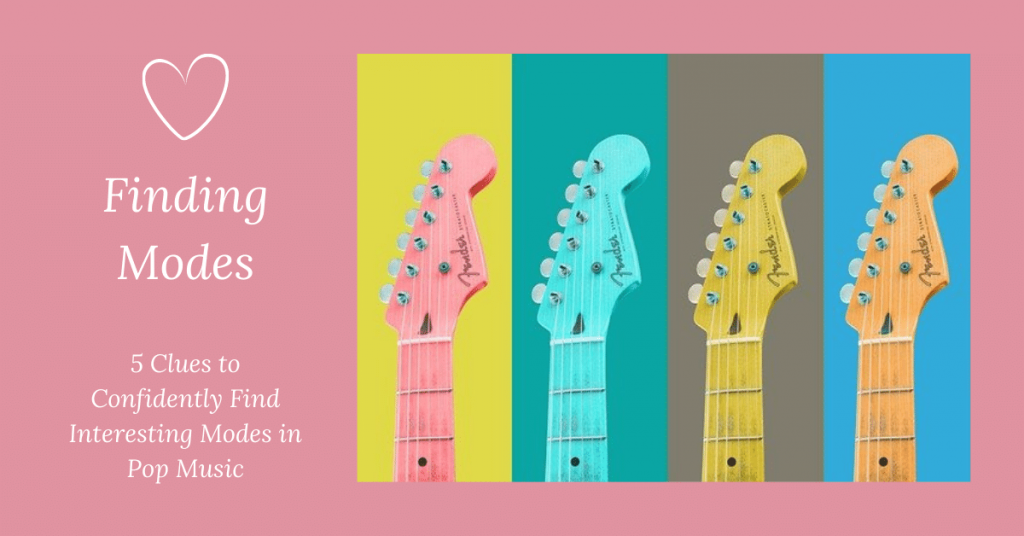5 Clues to Confidently Find Interesting Modes in Pop Music

Are you on the hunt for modes in pop songs? They are more common than you think!
I’m always on the lookout for interesting elements I can extract for my Kodály musicianship classes and piano students. Plus of course running a Pop Solfa Choir is far more rewarding if you can identify the songs with interest beyond just the melody. Modes provide this interest and reward.

This analysis of Weather with You by Crowded House was done in one of our live Doremi Member Musicianship sessions. We mix fun music making with accessible solfa musicianship and analysis for all levels. Each clue was carefully chosen to take the group step by step through the analysis of the modes whilst keeping the mood light and the understanding secure.
(Sofa Members: Visit the Sofa Dashboard for the video of this content)
Clue #1 Start with the bassline
Weather with You centres around E and A in the bass. Can you hear them? Starting on E.
So what would our first guess be?
A major? In relative solfa that would give us A-do and E-so? Good guess. With no other info I’d go with this too.
Of course since we’re looking for modes we could also consider A Lydian Mode, which would be A-fa and E-do.
Another option A Mixolydian Mode, which would be A-so and E-re.
Clue #2 Check out the chords

We have a few options already but here’s something to help or hinder. The E chord is actually E minor.
That’s a tick in the box for A Mixolydian Mode but there are still other modes it could be. For example A Aeolian Mode, otherwise known as A natural minor. In solfa we would have A-la and E-mi.
Oops, that would make the A chord minor too and guess what… it’s not! It’s MAJOR!
Back to A Mixolydian Mode then. Feeling confident?
Clue #3 What about the key signature?
So if we’ve whittled down our modes to A Mixolydian Mode that means A is so.
To work out the key signature we can do one of two things.
We could count up to find our do, which will be D, and remember our circle of fifths. D major (or D-do) has two sharps, F sharp and C sharp.
Alternatively we can use our knowledge of the positions of the tones and semitones, or whole steps and half steps. Semitones are between mi and fa, and also between ti and do. So we’re going to need an F sharp on mi and C sharp on ti.
do – re – mi-fa – so – la – ti-do
I’m feeling fairly certain that we need two sharps because the passing notes in the bassline include F sharp, C sharp… and… ok, also D sharp but that feels like a chromatic addition and not part of the scale. E major would have a D sharp but also a G sharp, which this doesn’t have since the E chord is E minor.
Clue #4 Sing the melody
Let’s assume our solfa is correct and we have D-do. The melody opens as follows
so, la, do re mi do la, do do do re
It continues through the whole verse just using this toneset. Nothing else.
With it’s pentatonic feel, I’m confident we have our do positioned correctly. It’s too neat not to be. However so doesn’t appear apart from that first note, which is part of the anacrusis and not the destination. The melody doesn’t feel so Mixolydian to me!
Clue #5 Feel for the home note
Have a listen to the introduction again. Can you hear the electric guitar? It’s E all over the show. 19 in the first two bars alone!
Also listen to the melody of the verse. Every line ends on E.
Hmm, do we know another mode? I’m certain our do is correct, so that would make E-re.
Which modal scale starts on E-re? E Dorian – of course.
Hooray! That’s it then, is it? Dorian Mode?
Yeah, I think so. Although it doesn’t stay there, that would be too easy.
The verse modulates into D minor (D Aeolian or D Dorian – we can discuss this later).
Then the chorus uses so and do chords giving it a very major feel until the end brings it back to the Dorian verse.
But then final chorus surprises us, finishing on do. Does that make the whole thing major then?
Like so many other pop songs we get a minor feel in the verses and then a major chorus. The end note is less significant than the other indicators along the way. So don’t think of the piece as a whole, with one ruling mode, rather a journey.
Who said pop music was simple and boring, not me! I LOVE IT!